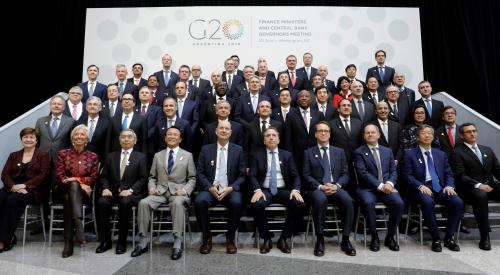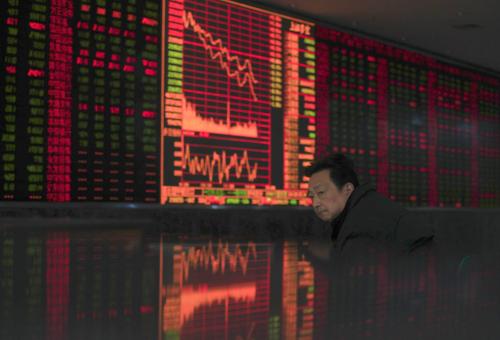Ten years ago, G-20 countries displayed an unprecedented level of multilateral cooperation in response to the global financial crisis. How times have changed. This weekend’s G-20 summit in Buenos Aires will look very different. Cooperation has been replaced with confrontation, solidarity with suspicion, and multilateralism with bilateralism.
A big bet on bilateralism
President Trump has made this weekend’s G-20 summit all about his bilateral meeting with Xi Jinping. This is a mistake. Trump’s 1980s are over. The challenges facing the world today, particularly in trade, cannot be solved bilaterally.
Bilateral responses to multilateral problems will—at best—entrench the sort of deadlocks we saw in APEC two weeks ago. At worst, they will legitimize fake solutions that risk permanently damaging the global system.
The G-20 must not allow itself to be sidelined so easily. It must learn the lessons of its past if it is to help the world navigate today’s turbulence. In a new working paper, I remind us of some of these past lessons. The paper analyses the economics and the politics of what was the centerpiece of the G-20’s multilateral cooperation during the crisis: a coordinated fiscal stimulus.
Ten years ago, countries promised to coordinate $5 trillion of fiscal stimulus to stop the Great Recession from becoming another Great Depression. The G-20 not only met this commitment. It exceeded it. From 2008 to 2010, the G-20 delivered $6.4 trillion of fiscal stimulus. But more importantly, the analysis of this period reminds us of two pertinent lessons which should be kept in mind for this weekend’s G-20 summit in Argentina.
Multilateralism is better
The first lesson is that the economic benefits of multilateral cooperation far exceed those from bilateral cooperation. Using a new computable general equilibrium model of the G-20, I show that the first-year GDP benefits from fiscal stimulus are, on average, twice as large when countries work together than when they act alone. For every dollar a country spends on fiscal stimulus, it gets the benefit of an extra dollar for free if other countries stimulate at the same time.
The same principle is true for trade. The benefits from lowering trade barriers are larger when more countries participate. Bilateral free trade deals achieve only a fraction of the benefits from multilateral trade liberalization in the WTO.
The model shows that trade deficits are fundamentally shaped by domestic policy settings, particularly fiscal policy. The U.S. trade deficit cannot be ‘solved’ bilaterally with China. A country (like the United States) that invests more than it saves imports capital from other countries (like China) to finance the investment. This inflow of capital appreciates the U.S. dollar, which reduces exports and increases imports, resulting in a trade deficit.
The U.S. trade deficit simply reflects its capital inflows from countries like China. It reflects the fact that U.S. consumers, firms and the government are borrowing to finance investment and consumption. A trade deal on the weekend in which China agrees to buy more U.S. exports will not change this underlying saving and investment arithmetic and will not, therefore, alter the overall trade balance.
The paper shows that the best way for Trump to reduce the U.S. trade deficit is to rein in his administration’s fiscal spending. Trump’s massive increase in the fiscal deficit, which has done nothing to lift investment or productivity will, by the end of 2018, require a U.S. government bond issuance of $1.34 trillion. If history is any guide, about half of that will have to be financed by foreign investors. My calculation is that this capital inflow will push up the U.S. dollar and worsen the U.S. trade deficit by around 0.6 percent in the first year.
There are issues in the global trading system that Trump has correctly identified as problems. But they cannot be solved bilaterally. They require a multilateral response—for which the G-20 is eminently suited—and include reforming and modernizing the World Trade Organisation and removing barriers to trade in services and digital trade, to name a few.
A strategic asset, not just a speech club
The second lesson from the paper is that the G-20 is a strategic asset. It provides political benefits, if used effectively.
Many query whether the G-20’s fiscal stimulus during the crisis was genuinely coordinated, given countries generally have an incentive to undertake stimulus regardless of what other countries do. To find out, I interviewed multiple politicians and officials from every G-20 country, 63 in total, including Kevin Rudd, Janet Yellen, Joe Hockey, Ben Bernanke, Jack Lew, Haruhiko Kuroda, Mark Carney, Wayne Swan, and 56 equally senior people.
The results were clear. Eleven of the G-20 economies undertook more fiscal stimulus because of the agreement at the G-20. “The G-20 played a positive role in the quantum of Australia’s fiscal stimulus,” said Kevin Rudd, Australia’s 26th Prime Minister. Politicians from ten other countries, usually smaller countries rather than larger ones, said the same thing, verified with data, where possible.
Politicians and officials said that the G-20 helps them to sell policies domestically. It gives them new ideas. It influences their thinking. It generates peer pressure. It helps defeat free-rider concerns and can result in countries being more ambitious in their commitments. It follows that the G-20 can, if used strategically, help its members achieve significant results.
It would be a tragedy if the U.S. and China allow their tactics in Buenos Aires to trump strategy.






Commentary
Trump and Xi at the G-20: Why bilateralism won’t work
December 1, 2018